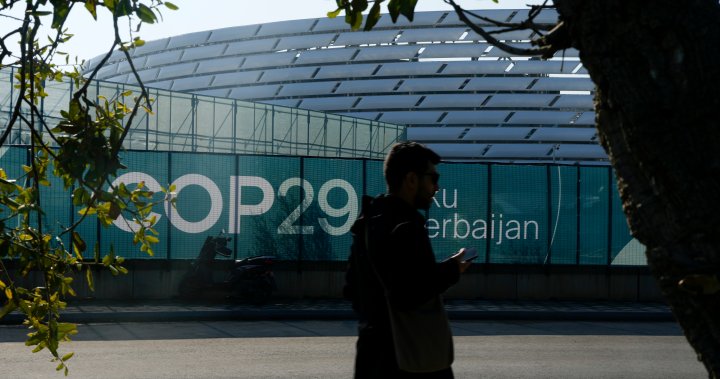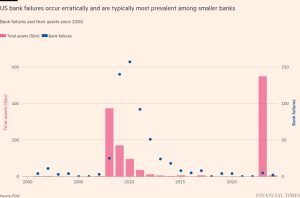As COP29 starts, what is Canada’s role in climate finance negotiations? – National

This year’s international climate talks are expected to be headlined by fraught negotiations over how Canada and other wealthy countries, who have contributed a disproportionate share of planet-warming emissions, should financially compensate other nations in their fight to tackle climate change.
Many pressing questions for negotiators are on the table: How much should those wealthy countries pay? Which countries will have to contribute? And how should the money be provided?
The answers may determine just how much money developing countries could receive for everything from renewable energy projects to wetlands conservation.
Failure to achieve a new goal at the United Nation’s annual climate talks may undercut confidence in major international agreements and strike a blow against efforts to limit global warming, observers say.
“It’s pretty high stakes,” said Bill Hare, CEO of Climate Analytics, a Berlin-based climate think tank.
Here’s what you need to know about the climate finance negotiations – and Canada’s role in them – as the 29th annual United Nations climate conference, or COP29, kicks off in Azerbaijan’s capital, Baku.

The UN climate talks have recognized that wealthy and historically high-emitting countries have a greater responsibility to solve the problem of climate change.
To put it in perspective, Canada and 22 other high-income countries – among them, the United States, Japan, Australia and Western European nations – are responsible for about half of estimated global emissions since the mid-19th century, despite making up about 12 per cent of the population. On a per-capita basis, Canada is among the most polluting countries.
Canada and those 22 other wealthy countries agreed in 2009 to mobilize $100 billion annually by 2020 to support other countries to mitigate their emissions and protect their citizens from the worst impacts of climate change. That funding has come from both public and private finance, such as government loans and grants or private sector investments in emerging green technology sectors.

For Canada, that’s led to contributions as varied as $225,000 for solar plants in Samoa to $240 million in grants for the world’s largest dedicated international climate fund. The Green Climate Fund has backed projects to expand Jamaica’s electric bus fleet and build one of the world’s largest solar energy projects in Egypt.
Yet, the international $100-billion goal was only met for the first time in 2022, two years late. In some cases, developing countries often struggled to access those funds, said Soomin Han, climate finance policy analyst at Climate Action Network Canada.
“That really led to… broken trust between global north and south,” said Han.
Against that backdrop, negotiating a new ambitious and fair international climate finance deal is a “moral imperative,” she said.
Why is climate finance set to dominate these talks?
Countries agreed to come up with a new collective goal by 2025 to replace the $100-billion mark. With that deadline looming, negotiators are expected to hammer out the details of the new pledge at COP29.

Get breaking National news
For news impacting Canada and around the world, sign up for breaking news alerts delivered directly to you when they happen.
It coincides with another deadline next year for countries to release their updated climate plans – outlining how they plan to cut emissions by 2035 in an effort to limit global warming to 1.5 degrees, as set out in the deal reached in Paris at COP21.
Setting a realistic climate finance goal will be key to making those plans a reality, said Catherine McKenna, Canada’s former environment minister.
“Emissions needs to go down at scale, money needs to go from fossil fuels to clean (energy) at scale, and then you have to think about people,” said McKenna.
“And you can’t do any of those three things without finance.”
How much does Canada owe?
Under the existing goal, Canada in 2021 doubled its international climate finance pledge to $5.3 billion over five years. A coalition of Canadian aid groups has pushed the government to at least triple that number, to $15.9 billion, for the next five-year period ending in 2031.
Naomi Johnson, co-chair of the Canadian Coalition on Climate Change and Development, or C4D, or called it a “down payment.”
“That would have to be a lot more going forward in order to achieve climate goals and reach our commitments globally,” said Johnson.
It would represent just a fraction of the larger goal set to be negotiated at the talks. Several independent assessments say developing countries may need upwards of $1 trillion to meet their climate goals.

United Nations Trade and Development, a UN institution which has proposed an annual goal of $1.46 trillion by 2030, suggested it would be roughly on par with what wealthy countries spend on their military budgets and less than their combined fossil fuel subsidies.
Canada, along with other wealthy countries, has not tabled a dollar-figure proposal.
Minister of Environment and Climate Change Steven Guilbeault suggested it may not be a single amount, reflecting layers of public and private sector financing, along with multilateral commitments from institutions such as the World Bank.
Yet, a possible roadblock to figuring out how much wealthy countries owe, some observers say, may be who needs to pay.
“The new climate finance pledge is going to be really, really messy negotiations,” said Catherine Abreu, director of the International Climate Politics Hub and a leading Canadian climate policy adviser.
The current list of 23 contributor countries is more than 30 years old. Wealthier countries, including Canada, are now suggesting that China and some Gulf states, for example, should be required to contribute to the new climate finance goal since their emissions have increased significantly as their economies have grown.
Yet, there’s concern that some wealthy countries may wield those arguments in a bad faith effort to shirk their responsibilities after years of coming up short on their own climate finance goals, said Abreu.
“Canada is also going to have to be able to play a constructive role of kind of bridging these divides,” she said.
What is Canada’s role in climate finance talks?
Guilbeault says Canada has played a central role for years in international climate finance talks.
“I think people see Canada as a reliable partner and bridge builder in these negotiations to help countries find solutions for these difficult discussions, and I certainly will be happy to try and play that role again in Baku this year,” he said in a recent interview.
Alongside Germany, Canada was asked to lead the charge on getting wealthy countries to meet the previous $100-billion goal.

More recently, Canada and Switzerland were the first countries to put forward specific eligibility criteria to expand the contributor base to include new countries. Canada’s proposal would see Russia, Saudi Arabia and China added to the list.
Canada has already shown leadership in navigating this “complex issue” said Han, the climate finance policy analyst with Climate Action Network Canada. Now, Canada must ensure negotiations over who pays don’t derail the adoption of a new goal.
“It needs to step up to build consensus between developed countries,” Han said.
Where should the money go and how should it be delivered?
Johnson, the C4D co-chair, suggested how countries deliver the new climate finance goal may be more important than the dollar figure. The coalition, along with developing countries, has been pushing for a greater share of climate finance to come in the form of government grants, rather than loans that can drive developing countries further into debt.
An analysis by the International Institute for Environment and Development found small island developing nations and the group of least developed countries spent about US$59 billion repaying debts in 2022, compared with $28 billion they received in climate finance. Of that US$28 billion, about half was provided as loans, the analysis suggested.
Johnson said it was “horrendous” that Canada was one of the largest providers of loans in its climate finance commitments.
Guilbeault said Canada was making progress and aiming for an even split between loans and grants in climate finance commitments, still short of the 60-40 loan-favoured split advocated for by the coalition.
“My hope is that we can get to 50-50 in the near future,” he said.
Observers have also pushed countries to better divide up money for projects that help countries reduce emissions and those that help them adapt to climate change impacts.
Complicating those discussions is the question of whether the goal should also include money to help pay for the losses and damages developing countries are already facing from climate change.
While last year’s talks kick-started a loss and damage fund, developing countries have expressed concerns that if it’s not included under the new goal, it may go underfunded.
Canada, an early supporter of that fund with a $16 million pledge, wants to keep it separate over concerns it could bog down negotiations.
The negotiations are set to tackle several other big issues, including how to transparently track the money and how to divide contributions between the public and private sector.
#COP29 #starts #Canadas #role #climate #finance #negotiations #National







